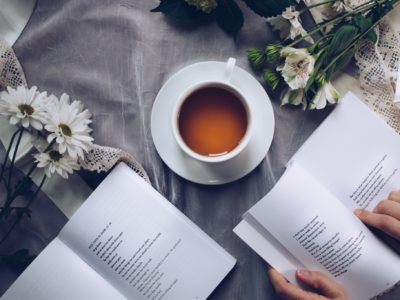Asian and Asian American literature sweeps over all sorts of genres, from contemporary to dystopian to mystery. Each story gives its own voice, its own hook that will draw you in. But where to start? Like Asia itself, the literature, described as expansive and unique, comes with a variety of stories lurking just around the corner.
If you want to venture into Asian and Asian American literature, then look no further: check out these ten books to begin your journey.
10. The Chosen and the Beautiful by Nghi Vo

As a retelling of The Great Gatsby, this book possesses everything the original contained and more: bright lights, roaring parties, and a touch of magic that brings everything to life. The story expands on Jordan Baker, a minor character from the original book. While she didn’t get nearly as fleshed out in the original, Vo molds her into a sharp, multi-layered woman with magic on her fingertips. With both sorcery and adaptive skills, Baker navigates the gilded world of wealthy socialites, and the things they have and want.
In addition to exploring the glitz and glamour of the 1920s, Vo also explores Baker’s heritage and position as a queer, Asian immigrant amongst a predominantly straight and white society. These themes all tie together to create a compelling retelling of the classic novel itself. So, jump right in and join the party—it’s bright enough to catch your eye.
9. The God of Small Things by Arundhati Roy

When considering a story about familial ties and how deep they run, The God of Small Things is the book to turn to. Set in Aymanam, a village located in Kerala, India, the story follows a pair of twins, Estha and Rahel, and the paths they embark on throughout life. Though the twins maintain the central focus, their surrounding family and friends also play a key role in the story. In fact, they shape the roads Estha and Rahel follow, what choices they both make as well as the ones they don’t. Every decision rests upon the impact it will have on their family and the societal expectations that infringe upon the two.
“It’s kind of a cool story [about] the distinctions between people who really mattered,” Loyola Marymount University senior Nishanth Ramasubramanian said. “It’s really good.”
In addition, Roy uses a unique narrative style throughout the course of the book: she switches from when the twins were children to when they were adults. Essentially, it describes the twins being together, trading off sequences and important plotlines as they do so. In this tight and twisted tale, The God of Small Things will tangle you deeper into the bonds of this particular family, and how everything around their world affects them.
8. Severance by Ling Ma

The apocalyptic genre has many different worlds in itself—sicknesses, natural disasters, zombies, you name it. In Severance, Ling Ma combines all of these tropes together to create a unique world centered on nostalgia. The protagonist, Candace Chen, struggles to adapt to a world following the Shen Fever, and is quickly coerced into joining a group of straggled survivors headed to Pennsylvania. As she travels with them, however, Candace comes to realize that the band of survivors is more dangerous than they seem.
What draws the story of Severance together is the world that Candace lives in—the world pre-Shen Fever, the world during the Shen Fever, and the world after it. Connected to all of it is old memories and remembrance, both of which are woven in Candace’s own narrative, and the apocalypse itself. The story also ties together two distinct ideas: Candace’s journey of being a Chinese immigrant from Fuzhou, and the idea of a fevered, nostalgic past. The story does contain eerie similarities to the pandemic world we live in today, but the world in Severance is definitely its own.
7. Never Let Me Go by Kazuo Ishiguro

At first glance, Never Let Me Go appears to take place in a beautiful world: students attend an elite boarding school to become well-versed in manners, arts, literature and more. Through the eyes of Kathy, one of these special students, everyone in this school is growing into a perfect model citizen—yet none of them are actually allowed to interact with the outside world. As the story develops, however, it becomes clear that this perfect school is only an illusion, and the world surrounding it is not as glamorous as it seems.
“I remember it’s dystopian,” Savannah College of Art and Design junior Grace Naify said. “The main character and her friends are meant to live a perfect life, [and everyone] is obsessed with being healthy. It was pretty disturbing, but I liked the narrator’s conversational style of addressing the reader.”
Never Let Me Go is haunting, in both its description and setting. As Kathy begins to unravel the mystery of her so-called perfect world, the reader also finds out what sorts of horrors lay just beyond the bubble. It’s a story that you will never want to let go.
6. The Last Story of Mina Lee by Nancy Jooyoun Kim

The Last Story of Mina Lee is a heart-wrenching tale about family, love and mysteries spanning across the past and the present. At the beginning of the novel, Margot visits her mother in Los Angeles, only to discover her mother died prior to her arrival. Because of the suspicion surrounding her mother’s death, and nobody else willing to help out, Margot resolves to dig deeper and discover what truly lead to her mother’s death. But as she does so, her mother’s precarious past begins to unwind, and Margot gets left wondering how much she truly knows about her mother.
The story gets separated into two different narratives: Mina and Margot Lee. Of course, the two connect through their familial bonds, but as the story continues, it’s clear that their narratives also tie together. The heart of the novel lies with Mina: she poses as the most prominent figure in both narratives. In an ironic twist, the story would not survive without Mina’s death, but to understand it, her backstory must also be explained. As the mystery continues, you’ll also find yourself sympathizing with Margot, wanting to solve the mystery with her as she desperately combs for clues in her mother’s past. This may be the last story of Mina Lee, but it definitely will capture your interest the whole way through.
5. The Memory Police by Yoko Ogawa

The Memory Police definitely makes itself a story to remember—rather ironic, because the book’s sets itself up as all about forgetting and remembering objects. The story centers on the inhabitants of an island, where people get forced to forget simple, mundane objects like birds and ribbons. The Memory Police strip away any reminder of these things, and promptly arrest people who do recall anything. The unnamed protagonist, a writer, discovers that her editor still knows all the disappeared objects—and thus does her best to help preserve him from the Memory Police.
Poignant and thrilling, The Memory Police draws you into this world of memories and forgetting. Like the protagonist, there’s a curiosity as to why they must forget their memories—so you will certainly want to unravel the mystery as the story goes on. At the end of it all, the story will definitely linger in your head for days.
4. If I Had Your Face by Frances Cha

If I Had Your Face tells the story of four different women, living in the same apartment complex in South Korea: Ara, Kyuri, Miho and Wonna. While each of their stories vary, they find themselves related through their interactions and dynamics with each other. Kyuri and Miho room together, for example, and Ara lives just down the hall from them; Wonna, slightly older than the other three, lives below them with her husband. As their stories intertwine, each narrator spins their own perspective of one another, so it’s interesting to see how one character views another.
Each woman deals with a different arc involving contemporary topics present in South Korea today. However, certain themes get weaved in each story: beauty, for example, poses as a prominent subject laced in all four stories. As their stories deepen, so do their bonds, tying together a poignant tale about their individual arcs and the friendships that ground them.
3. On Earth We Are Briefly Gorgeous by Ocean Vuong

On Earth We Are Briefly Gorgeous: a unique tale written as a set of letters from a son to his mother. The narrator, Little Dog, writes to his mother in English, although she doesn’t understand what he’s written; precisely why he writes to her in this format. As Little Dog describes his life and feelings to his mother, you truly get to understand him as a character, his intricate relationship with his mother, his experience growing up as her son and the people who impacted his life beyond her.
What also ties together this story is how lyrical the novel reads. The story almost reads like a poem in itself, and each word feels chosen with great care, making every sentence a masterpiece. Through this format, you also see the care Little Dog pays towards his mother. At the end of this poignant, illustrative story, you’ll find that each word reached deep within the heart.
2. Everything I Never Told You by Celeste Ng

On the surface of Everything I Never Told You, you’d think the story follows a mystery surrounding young Lydia’s Lee death. It’s the event that kickstarts everything, after all—when fifteen-year-old Lydia is found drowned in a lake, her family gets left shaken by the events, and wondering what could’ve led her to death. As the story unfolds, it slowly becomes clearer that Lydia’s death unlocked a tirade of things the Lee family kept from each other, both before and after her death. The heart of the novel, ultimately, doesn’t focus on Lydia’s death, but the things that spurred it, and the resulting collisions afterwards.
“I like how the story is reversed,” Loyola Marymount University junior Michelle Chang said. “Usually [in books], you see everything leading up to the character dying. Here, it’s the opposite, where they try to figure out why she died. It’s really gripping and detailed.”
A very character-driven book, the main focal point remains the Lee family—James, Marilyn, Nath, Lydia and Hannah—and each character plays an important role in the story. The narrative sequence weaves together the past and the present seamlessly, giving each character a voice in practically every chapter. It’s a unique narration style that doesn’t get commonly employed, yet leaves the reader hooked. And as the story progresses, you, too, will want to know: what led to Lydia’s death? Not to worry—the book will definitely tell you.
1. America Is Not the Heart by Elaine Castillo

America Is Not the Heart revolves around Hero de Vera, a Filipino woman who gets disowned by her parents and moves in with her uncle and his family in America. Hero is, of course, the literal hero of the story, but she shares the role as the heart of the story with another character: Roni. As the novel progresses, Hero adjusts to her life in San Francisco, as well as her new role in her uncle’s family. Like all else, the story makes itself central to family, but also Hero’s past—and why she needed to come to America in the first place.
What makes America Is Not the Heart flow? The story, and the narration style of it. The narrative tends to flow together, without any quotation marks. It also mixes together various languages, including English, Tagalog, Pangisian and Ilocano. Hero also occasionally flashes back to the past, which brings the story together in a full circle. In this novel, America may not be the heart—but its strong characters most definitely make it.



















